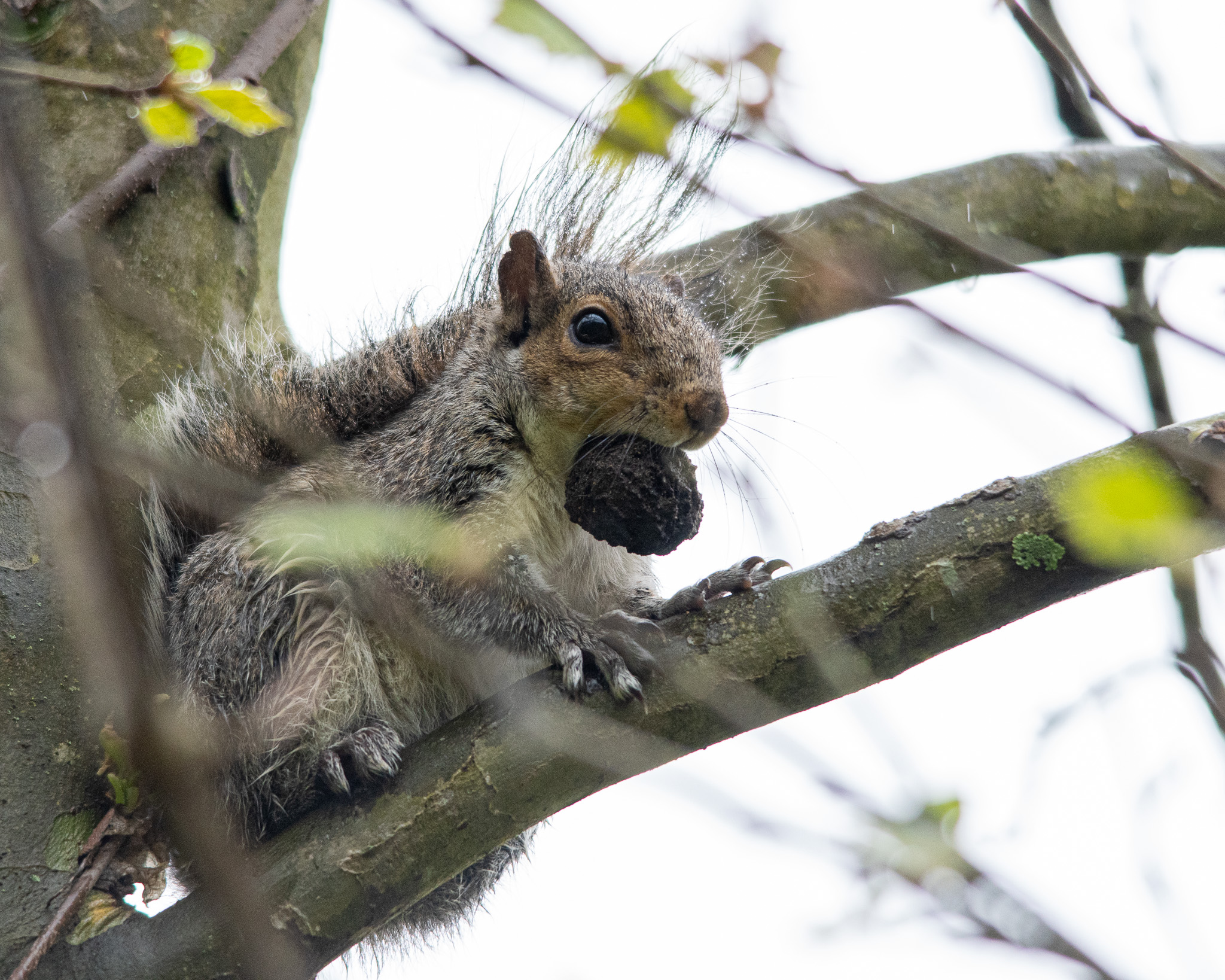January 5, 2022
Flying Squirrels

Director’s Blog by John Canoles
Flying Squirrels
A midday snow piles up on the lip of a knothole in an old silver maple. The maple, planted long ago at the edge of an old homestead for shade, now stands at the edge of the forest. The homestead’s former presence is now revealed only by an old stone foundation and this old tree.
The craggy old silver maple provides a multitude of habitat opportunities throughout the year. Each spring the seeds of this old giant provide a source of food for squirrels and songbirds. The young ends of its drooping branches are a favored food of deer in the spring and its still moist, fallen leaves are equally prized in the fall. Its broad branches provide nesting opportunities for birds and gray squirrels all summer and the large cavity that runs from the base of the tree up through its main trunk serves as shelter for raccoons and an opossum through the winter. This dark cavity could also host roosting bats. High in the canopy, the dead end of a branch has been hollowed out by downy woodpeckers who nest there through the summer.
The knothole collecting the midday snow provides access to a small cavity midway up the main trunk of the tree. Inside the knothole, in a warm, dry cluster of leaves, moss, and a few scavenged feathers, a southern flying squirrel is sleeping. Tucked neatly in a ball, it looks like large mouse. Its fur is dense, brown above and white on the belly, its long flat tail is wrapped over its head, keeping in warmth, and shading its large eyes from any glimpse of light.
The southern flying squirrel is common in our forested habitats but rarely noticed. Unlike its sun-loving cousin the gray squirrel, the flying squirrel is nocturnal, becoming active after the sun sets. Life in the shadows of the evening forest cloaks its presence from most. Its quick, agile, and evasive movements help to keep its presence a secret as well.
By sundown the snow has settled, and the landscape is brightened by the rising moon. The flying squirrel emerges from its nest and scampers up to the highest heights of the maple. In an instant it leaps, taking “flight” into the dark night sky. While not flying in the same manner as a bird or bat, the squirrel soars on “wings” created by skin that stretches between its wrists and its ankles. Weighing only few ounces, the squirrel can soar long distances though the landscape.
Angling down through the forest the squirrel uses its legs and flattened tail to steer its flight. It slips safely past tree limbs before taking aim on landing spot near the base of a large white oak. Swooping upward at the last moment, the squirrel lands softly onto the tree and quickly darts to the opposite side, disappearing into the shadows.
Flying squirrels can be prey to any number of forest predators, great horned owl, snakes, raccoons, and house cats, so they have developed evasive maneuvers to help protect themselves. One such maneuver is the ability to turn 90 degrees in flight to avoid a predator. Their large eyes help them see in the low light of their nighttime world.
Though most comfortable in the trees, the squirrel drops to the ground and scampers to collect an acorn before quickly retreating to the cover of the darkened tree trunk. Its diet includes a wide variety of seeds, nuts, and insects. Flying squirrels will also feed on mushrooms, lichens and sometimes even bird eggs. When food is plentiful the flying squirrel will store food in caches throughout its home range.
The squirrel dares not venture too far from the safety of the tree trunk. Though agile and elusive in the trees, the skin that gives them flight can be cumbersome on the ground. The slightest startle and the squirrel darts up the tree, circling the trunk so quickly it seems to defy gravity. In the blink of an eye, it is gone.
For many people the flying squirrel only exists in pictures, or as the unknown source of a loud chirp call that is made as an alert of danger. Interestingly, most of their communications are so high pitched that even their calls evade human detection. An unfortunately frequent sign that flying squirrels are, or were, living in an area, is the discovery of a severed tail on the ground. This is the sign that an owl snatched up an unwitting squirrel, nipped off its meatless tail and dropped it to the ground as it flew off. A sad sign, but a sign, nonetheless.
A good source of flying squirrel sightings is a bird feeder mounted to the trunk of a large old tree at or near the forest edge. Even the standard gray squirrel “proof” feeder is no match for the lightweight and agile flying squirrel. Sunflower seeds are a welcome treat for these aerialists, and they will happily visit a nighttime feeder. They are not as likely to come if the feeder is well lit but will stay in place if the feeder is illuminated briefly for view. You do have to be patient and lucky, but with a little of both you can capture a real time view of these wonderful creatures. If you fear that you are neither patient nor lucky, a game camera aimed at the feeder will likely yield good results.
Male flying squirrels will often form into groups through the winter. The group setting provides more warmth in the nest and greater protection from predators. The more eyes the better in a forest full of possible predators. Females often remain solitary, choosing to protect the best nesting territories instead of sharing in the benefits of communal living. By early-spring the squirrels will find a mate and begin their first family of the season. By mid-summer they will begin their second. Having 3-4 babies per litter, they can maintain a population despite the threat of predators.
As the night deepens and moves toward dawn, the flying squirrel makes one last flight back to the silver maple as a great horned owl calls out in from the forest. Landing with swoop and a dash it safely returns to its home tree and scampers back to its snowy knothole to sleep off the night. Nearby, a gray squirrel begins to get restless in its nest, eager to start another day.

